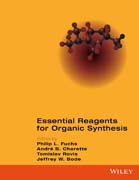
Essential Reagents for Organic Synthesis
Fuchs, Philip L.
Charette, André B.
Rovis, Tomislav
Bode, Jeffrey W.
From Boron Trifluoride to Zinc, the 52 most widely used reagents in organic synthesis are described in this unique desktop reference for every organic chemist. The list of reagents contains classics such as N–Bromosuccinimide (NBS) and Trifluoromethanesulfonic Acid side by side with recently developed ones like Pinacolborane and Tetra–n–propylammonium Perruthenate (TPAP). For each reagent, a concise article provides a brief description of all important reactions for which the reagent is being used, including yields and reaction conditions, an overview of the physical properties of the reagent, its storage conditions, safe handling, laboratory synthesis and purification methods. Advantages and disadvantages of the reagent compared to alternative synthesis methods are also discussed. Reagents have been hand–picked from among the 5000 reagents contained in EROS, the Encyclopedia of Reagents for Organic Synthesis. Every organic chemist should be familiar with these key reagents that can make almost every reaction work. INDICE: Preface ix .Short Note on InChIs and InChIKeys xi .General Abbreviations xiii .Bis(dibenzylideneacetone)palladium(0) 2 .9–Borabicyclo[3.3.1]nonane Dimer 17 .Boron Trifluoride Etherate 27 .N–Bromosuccinimide 43 .n–Butyllithium 54 .N,N[1]–Carbonyl Diimidazole 72 .Cerium(IV) Ammonium Nitrate 80 .m–Chloroperbenzoic Acid 87 .N–Chlorosuccinimide 98 .Chlorotrimethylsilane 108 .Chlorotris(triphenylphosphine)–rhodium(I) 121 .(Diacetoxyiodo)benzene 136 .Diazomethane 145 .2,3–Dichloro–5,6–dicyano–1,4–benzoquinone 152 .Diisobutylaluminum Hydride 164 .4–Dimethylaminopyridine 170 .Dimethyldioxirane 176 .1–Ethyl–3–(3[1]–dimethylaminopropyl) carbodiimide Hydrochloride 184 .N–Iodosuccinimide 188 .Iodotrimethylsilane 194 .2–Iodoxybenzoic Acid 206 .Lithium Aluminum Hydride 212 .Lithium Diisopropylamide 224 .Lithium Naphthalenide 241 .Manganese Dioxide 248 .Osmium Tetroxide 264 .Oxalyl Chloride 283 .Oxalyl Chloride Dimethylformamide 288 .Ozone 290 .Pinacolborane 306 .Potassium Hexamethyldisilazide 313 .Potassium Monoperoxysulfate 334 .Potassium tert–Butoxide 353 .Ruthenium(II), Tris(2,2[1]–bipyridine– N1, N1[1])–, (OC–6–11)– 370 .Samarium(II) Iodide 378 .Scandium Trifluoromethanesulfonate 388 .Sodium Azide 398 .Sodium Borohydride 406 .Sodium Cyanoborohydride 419 .Sodium Hexamethyldisilazide 428 .Sodium Hydride 438 .Sodium Periodate 447 .Tetrabutylammonium Fluoride 458 .Tetrakis(triphenylphosphine)–palladium(0) 467 .Tetra–n–propylammonium Perruthenate 476 .p–Toluenesulfonyl Chloride 480 .Triethylsilane 489 .Trifluoromethanesulfonic Acid 498 .Trifluoromethanesulfonic Anhydride 507 .Trimethylsilyl Trifluoromethanesulfonate 524 .Trimethylsilyldiazomethane 543 .Zinc Acetic Acid 554 .List of Contributors 000 .Subject Index 000
- ISBN: 978-1-119-27830-6
- Editorial: Wiley–Blackwell
- Encuadernacion: Rústica
- Páginas: 640
- Fecha Publicación: 16/09/2016
- Nº Volúmenes: 1
- Idioma: Inglés
